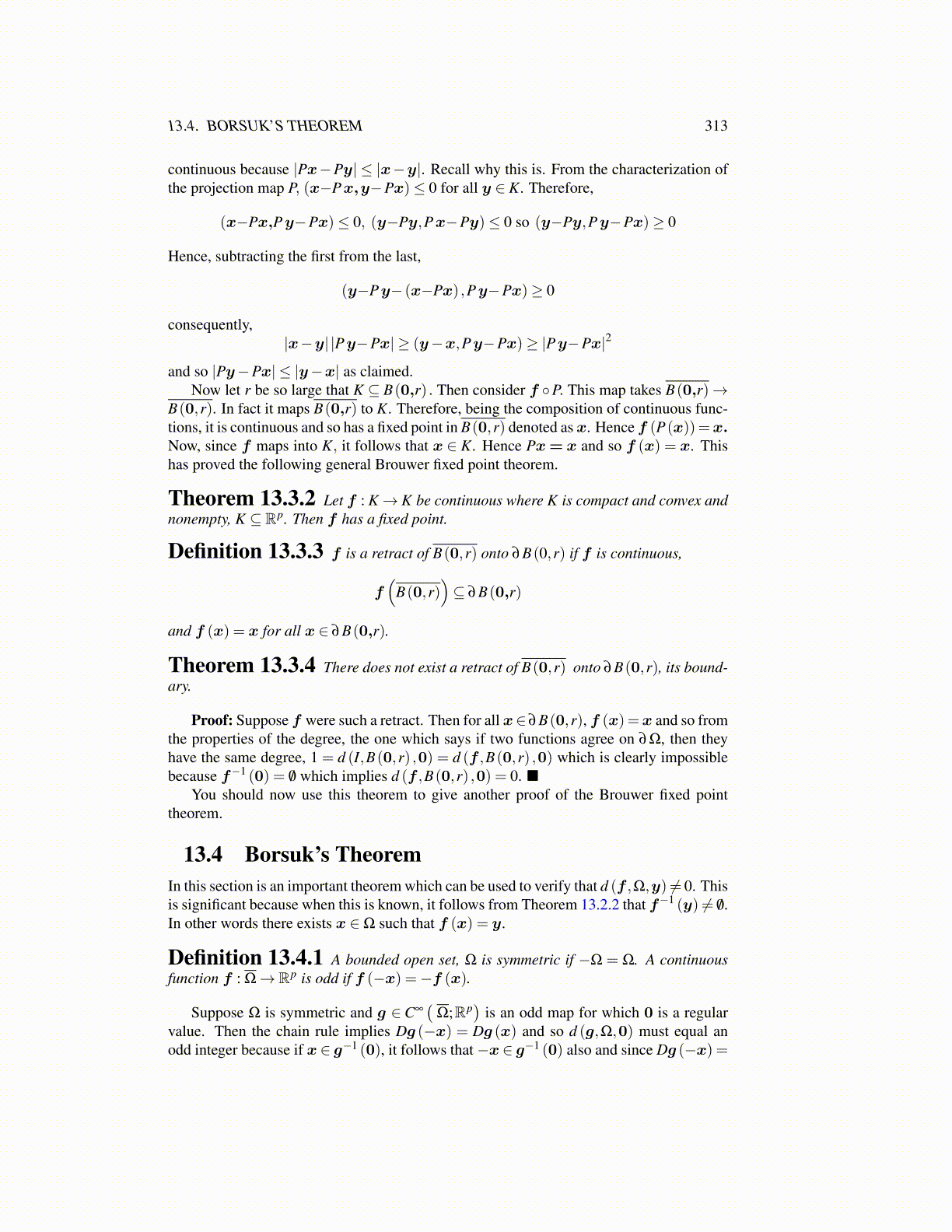
13.4. BORSUK’S THEOREM 313
continuous because |Px−Py| ≤ |x−y|. Recall why this is. From the characterization ofthe projection map P, (x−Px,y−Px)≤ 0 for all y ∈ K. Therefore,
(x−Px,Py−Px)≤ 0, (y−Py,Px−Py)≤ 0 so (y−Py,Py−Px)≥ 0
Hence, subtracting the first from the last,
(y−Py− (x−Px) ,Py−Px)≥ 0
consequently,|x−y| |Py−Px| ≥ (y−x,Py−Px)≥ |Py−Px|2
and so |Py−Px| ≤ |y−x| as claimed.Now let r be so large that K ⊆ B(0,r) . Then consider f ◦P. This map takes B(0,r)→
B(0,r). In fact it maps B(0,r) to K. Therefore, being the composition of continuous func-tions, it is continuous and so has a fixed point in B(0,r) denoted as x. Hence f (P(x))=x.Now, since f maps into K, it follows that x ∈ K. Hence Px= x and so f (x) = x. Thishas proved the following general Brouwer fixed point theorem.
Theorem 13.3.2 Let f : K→ K be continuous where K is compact and convex andnonempty, K ⊆ Rp. Then f has a fixed point.
Definition 13.3.3 f is a retract of B(0,r) onto ∂B(0,r) if f is continuous,
f(
B(0,r))⊆ ∂B(0,r)
and f (x) = x for all x ∈ ∂B(0,r).
Theorem 13.3.4 There does not exist a retract of B(0,r) onto ∂B(0,r), its bound-ary.
Proof: Suppose f were such a retract. Then for all x∈ ∂B(0,r), f (x)=x and so fromthe properties of the degree, the one which says if two functions agree on ∂Ω, then theyhave the same degree, 1 = d (I,B(0,r) ,0) = d (f ,B(0,r) ,0) which is clearly impossiblebecause f−1 (0) = /0 which implies d (f ,B(0,r) ,0) = 0. ■
You should now use this theorem to give another proof of the Brouwer fixed pointtheorem.
13.4 Borsuk’s TheoremIn this section is an important theorem which can be used to verify that d (f ,Ω,y) ̸= 0. Thisis significant because when this is known, it follows from Theorem 13.2.2 that f−1 (y) ̸= /0.In other words there exists x ∈Ω such that f (x) = y.
Definition 13.4.1 A bounded open set, Ω is symmetric if −Ω = Ω. A continuousfunction f : Ω→ Rp is odd if f (−x) =−f (x).
Suppose Ω is symmetric and g ∈ C∞(
Ω;Rp)
is an odd map for which 0 is a regularvalue. Then the chain rule implies Dg (−x) = Dg (x) and so d (g,Ω,0) must equal anodd integer because if x ∈ g−1 (0), it follows that−x ∈ g−1 (0) also and since Dg (−x) =